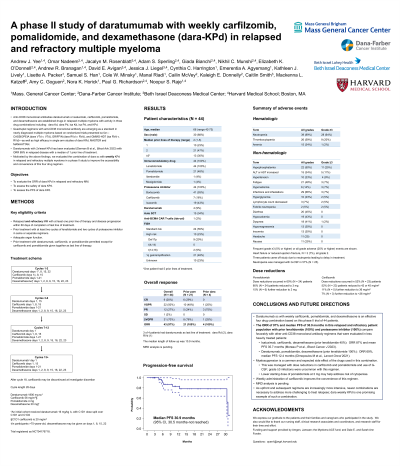Treatment of Relapsed/Refractory Myeloma
Poster Session 2
P-329: A phase II study of daratumumab with weekly carfilzomib, pomalidomide, and dexamethasone in relapsed and refractory multiple myeloma
Thursday, September 28, 2023
12:30 PM - 1:30 PM EEST


Andrew J. Yee, MD
Clinical Director, Center for Multiple Myeloma
Massachusetts General Hospital Cancer Center
Boston, Massachusetts, United States
Introduction: Daratumumab (dara), carfilzomib (K), pomalidomide (P), and dexamethasone (d) are established therapies in relapsed multiple myeloma (MM) with activity in 3-drug combinations including: dara Kd; dara Pd; and KPd. The paradigm in MM is moving towards more intensive and well-tolerated combinations to achieve deeper and more durable responses while ensuring tolerability. Quadruplet regimens are now becoming standard in newly diagnosed MM, and we explored a 4-drug regimen in relapsed disease. A phase 2 study of dara KPd with a twice/week schedule of K showed an ORR of 89% in pts with a median of 1 prior line (Derman B et al., Blood Adv 2023). Here we report an ongoing study of dara with weekly KPd (dara wKPd) to improve the schedule and tolerability of this regimen.
Methods: This phase 2 study (NCT04176718) enrolled pts with relapsed/refractory MM who received at least 1 prior therapy, including both lenalidomide and a proteasome inhibitor. Prior therapy with dara, K, or P was permitted except for K and P given together as last line of therapy. Dara wKPd was given on a 28-day schedule, and dara was given according to the dara Pd schedule. An initial cohort (N=16) received dara 16 mg/kg iv (with 1st dose split over two days); the trial was amended to dara 1800 mg sc. K 56 mg/m2 iv was given weekly on days 1, 8, 15 for cycles 1-12 and days 1, 15 for cycles 13+; for C1D1, dose was 20 mg/m2. P 4 mg was given po on days 1-21. Dex 40 mg was given weekly with the dose split over two days. Treatment was until progression or unacceptable toxicity. The primary endpoints were overall response and the safety profile of dara wKPd. Secondary endpoints included PFS.
Results: We enrolled 44 pts, and accrual is complete. Median age was 66 (range 42-73), and median number of prior lines was 2 (range 1-5). All pts were refractory to their last line of therapy and all had prior lenalidomide and proteasome inhibitor. Prior therapies included: pomalidomide (48%), bortezomib (93%), carfilzomib (16%), ixazomib (43%), daratumumab (9%), auto SCT (34%), and ide-cel (2%). High risk FISH: del 17p (20%); t(14;16) (5%); gain of 1q (45%). Median follow up was 10.9 months. 3 pts came off study due to neutropenia leading to delay in treatment. Overall response rate was 98% (PR 27%, VPGR 50%, CR 20%). Median PFS was 30.9 months (95% CI 30.5-not reached). Grade 3-4 hematologic AEs included neutropenia (64%) and thrombocytopenia (20%). Febrile neutropenia occurred in 5%. Non hematologic AEs (all; grade 3-4) included infections (66%; 7%); fatigue (48%; 7%); dyspnea (41%; 2%); increase in ALT/AST (34%; 11%); heart failure or reduced ejection fraction (7%; 0%). There were no hospitalizations or deaths from COVID19.
Conclusions: Dara wKPd shows some of the highest response rates (98%) and median PFS (30.9 months) in relapsed/refractory MM. This highlights the efficacy of 4-drug regimens and builds on the established activity of dara, K, and P, with manageable toxicity and convenience of weekly K.
Methods: This phase 2 study (NCT04176718) enrolled pts with relapsed/refractory MM who received at least 1 prior therapy, including both lenalidomide and a proteasome inhibitor. Prior therapy with dara, K, or P was permitted except for K and P given together as last line of therapy. Dara wKPd was given on a 28-day schedule, and dara was given according to the dara Pd schedule. An initial cohort (N=16) received dara 16 mg/kg iv (with 1st dose split over two days); the trial was amended to dara 1800 mg sc. K 56 mg/m2 iv was given weekly on days 1, 8, 15 for cycles 1-12 and days 1, 15 for cycles 13+; for C1D1, dose was 20 mg/m2. P 4 mg was given po on days 1-21. Dex 40 mg was given weekly with the dose split over two days. Treatment was until progression or unacceptable toxicity. The primary endpoints were overall response and the safety profile of dara wKPd. Secondary endpoints included PFS.
Results: We enrolled 44 pts, and accrual is complete. Median age was 66 (range 42-73), and median number of prior lines was 2 (range 1-5). All pts were refractory to their last line of therapy and all had prior lenalidomide and proteasome inhibitor. Prior therapies included: pomalidomide (48%), bortezomib (93%), carfilzomib (16%), ixazomib (43%), daratumumab (9%), auto SCT (34%), and ide-cel (2%). High risk FISH: del 17p (20%); t(14;16) (5%); gain of 1q (45%). Median follow up was 10.9 months. 3 pts came off study due to neutropenia leading to delay in treatment. Overall response rate was 98% (PR 27%, VPGR 50%, CR 20%). Median PFS was 30.9 months (95% CI 30.5-not reached). Grade 3-4 hematologic AEs included neutropenia (64%) and thrombocytopenia (20%). Febrile neutropenia occurred in 5%. Non hematologic AEs (all; grade 3-4) included infections (66%; 7%); fatigue (48%; 7%); dyspnea (41%; 2%); increase in ALT/AST (34%; 11%); heart failure or reduced ejection fraction (7%; 0%). There were no hospitalizations or deaths from COVID19.
Conclusions: Dara wKPd shows some of the highest response rates (98%) and median PFS (30.9 months) in relapsed/refractory MM. This highlights the efficacy of 4-drug regimens and builds on the established activity of dara, K, and P, with manageable toxicity and convenience of weekly K.
